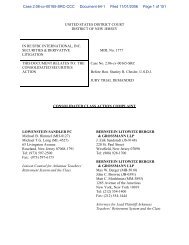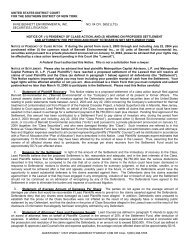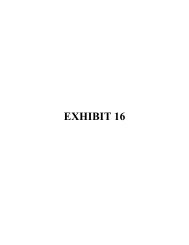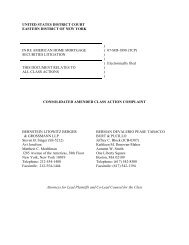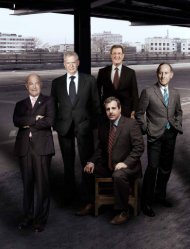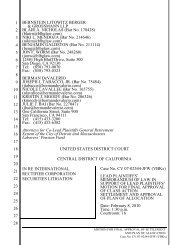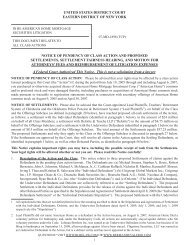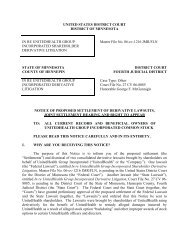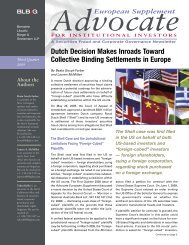Toyota Motor Corp. Securities Litig - OakBridge Insurance Services
Toyota Motor Corp. Securities Litig - OakBridge Insurance Services
Toyota Motor Corp. Securities Litig - OakBridge Insurance Services
You also want an ePaper? Increase the reach of your titles
YUMPU automatically turns print PDFs into web optimized ePapers that Google loves.
Case 2:10-cv-00922-DSF -AJW Document 213 Filed 07/07/11 Page 1 of 11 Page ID#:4327UNITED STATES DISTRICT COURTCENTRAL DISTRICT OF CALIFORNIAMEMORANDUMCase No. CV 10-922 DSF (AJWx) Date 7/ 7 /11TitleIn re <strong>Toyota</strong> <strong>Motor</strong> <strong>Corp</strong>. <strong>Securities</strong> <strong>Litig</strong>.Present: The DALE S. FISCHER, United States District JudgeHonorableDebra PlatoNot PresentDeputy ClerkCourt ReporterAttorneys Present for Plaintiffs: Attorneys Present for Defendants:Proceedings:Not PresentNot Present(In Chambers) Order GRANTING IN PART and DENYING INPART Motion to Dismiss (Docket No. 180, 193, 201)I. BACKGROUNDThis suit under the Private <strong>Securities</strong> <strong>Litig</strong>ation Reform Act (“PSLRA”) arises outof statements by employees of Defendants <strong>Toyota</strong> <strong>Motor</strong> <strong>Corp</strong>oration, <strong>Toyota</strong> <strong>Motor</strong>North America, Inc., and <strong>Toyota</strong> <strong>Motor</strong> Sales, U.S.A., Inc. made against a background ofallegations of defects in <strong>Toyota</strong> vehicles.In around 2000, <strong>Toyota</strong> received the first of what would eventually be thousands ofreports of unintended acceleration in several models of both the <strong>Toyota</strong> and Lexus brandvehicles. These reports continued through the last decade and were the subject of at leasteight investigations by the National Highway Traffic and Safety Administration(“NHTSA”) between 2003 and 2010. <strong>Toyota</strong> identified driver error and non-standard ormisaligned floor mats as the source of the problem.In the meantime, <strong>Toyota</strong> began acquiring internal evidence that the unintendedacceleration might have been due to a more serious mechanical or electrical defect in thedesign of the cars themselves. <strong>Toyota</strong> technicians were able to reproduce unintendedacceleration not related to floor mat placement on several occasions. (Compl. 73, 87.)In early 2010, in the face of increasing reports of accidents related to unintendedacceleration, <strong>Toyota</strong> was forced to admit that many of its vehicles were subject to severaldesign defects. It instituted recalls at an estimated cost of ¥380 billion (~$4 billion).CV-90 (12/02) MEMORANDUM Page 1 of 11
Case 2:10-cv-00922-DSF -AJW Document 213 Filed 07/07/11 Page 2 of 11 Page ID#:4328UNITED STATES DISTRICT COURTCENTRAL DISTRICT OF CALIFORNIAMEMORANDUM(Compl. 141.) By the end of a wave of revelations, <strong>Toyota</strong>’s stock price had dropped atleast 11%. (See Compl. 180-187.) The size and severity of the defects prompted botha NHTSA investigation and investigations by Congress. On April 19, 2010, the NHTSAfined <strong>Toyota</strong> $16.4 million for failure to comply with regulations regarding defectdisclosure. (Compl. 139.)Numerous securities fraud suits followed, many of which are consolidated in thisaction. Defendants now move to dismiss the consolidated complaint.II. LEGAL STANDARDLiability under § 10(b) of the <strong>Securities</strong> Exchange Act of 1934 and <strong>Securities</strong> andExchange Commission Rule 10b-5 requires a showing that the defendants (1) made amaterial misrepresentation (or omission), (2) with scienter, (3) in connection with thepurchase or sale of a security, (4) reliance by the plaintiff, (5) economic loss, and (6)“loss causation.” Dura Pharms., Inc. v. Broudo, 544 U.S. 336, 341-42 (2005).To plead falsity, a securities fraud plaintiff is required to “specify each statementalleged to have been misleading” and provide “the reason or reasons why the statement ismisleading.” 15 U.S.C. § 78u-4(b)(1).Scienter is “a mental state embracing intent to deceive, manipulate, or defraud.”Ernst & Ernst v. Hochfelder, 425 U.S. 185, 193-94 & n.12 (1976). In a typical fraudcase, knowledge and intent can be alleged generally. See Fed. R. Civ. P. 9(b). However,allegations of scienter must meet a higher standard under the PSLRA. In such cases, aplaintiff is required to “state with particularity facts giving rise to a strong inference thatthe defendant acted with the required state of mind.” 15 U.S.C. § 78u-4(b)(2). Aninference of scienter is “strong” if “a reasonable person would deem the inference ofscienter cogent and at least as compelling as any opposing inference one could draw fromthe facts alleged.” Tellabs, Inc. v. Makor Issues & Rights, Ltd., 551 U.S. 308, 324(2007). The inference “need not be irrefutable, i.e., of the ‘smoking gun’ genre, or eventhe most plausible of competing inferences.” Id. (internal quotation marks omitted). Indetermining whether the inference of scienter is strong, courts are to accept all factualallegations in the complaint as true and examine the allegations in their entirety. Id. at322. “The inquiry . . . is whether all of the facts alleged, taken collectively, give rise to astrong inference of scienter, not whether any individual allegation, scrutinized inisolation, meets that standard.” Id. at 322-23. In evaluating a pleading of scienter, acourt “must take into account plausible opposing inferences.” Id. at 323.The strength of an inference cannot be decided in a vacuum. The inquiry isCV-90 (12/02) MEMORANDUM Page 2 of 11
Case 2:10-cv-00922-DSF -AJW Document 213 Filed 07/07/11 Page 3 of 11 Page ID#:4329UNITED STATES DISTRICT COURTCENTRAL DISTRICT OF CALIFORNIAMEMORANDUMinherently comparative: How likely is it that one conclusion, as compared toothers, follows from the underlying facts? To determine whether the plaintiffhas alleged facts that give rise to the requisite ‘strong inference’ of scienter, acourt must consider plausible nonculpable explanations for the defendant’sconduct, as well as inferences favoring the plaintiff.Id. at 323-24.Loss causation requires “that the defendant’s misrepresentation (or other fraudulentconduct) proximately caused the plaintiff’s economic loss.” Dura Pharms., 544 U.S. at346. “[T]he plaintiff must demonstrate a causal connection between the deceptive actsthat form the basis for the claim of securities fraud and the injury suffered by theplaintiff.” In re Daou Systems, Inc., 411 F.3d 1006, 1025 (9th Cir. 2005). “Themisrepresentation need not be the sole reason for the decline in value of the securities, butit must be a ‘substantial cause.’” In re Gilead Sciences <strong>Securities</strong> <strong>Litig</strong>., 536 F.3d 1049,1055 (9th Cir. 2008).III. DISCUSSIONA. Scienter is Not Adequately Alleged for Statements 1, 3-7, 9-12, 14-17, 22, 23,25, 27, and 33 1Plaintiffs allege that numerous statements about <strong>Toyota</strong>’s legal and regulatorycompliance were false because <strong>Toyota</strong> was not, in fact, living up to its statutory andregulatory duties. Plaintiffs have not adequately alleged scienter as to these statementsbecause it is more plausible – based on the limited facts in the complaint – thatDefendants believed their responses to the NHTSA were within the scope of anaggressive defense under the law, rather than an intentional violation of the law.Plaintiffs simply do not allege any facts that show Defendants were knowingly violatinglaws or regulations.Plaintiffs also fail to allege scienter adequately as to the generalized quality andsafety statements. Nothing in the complaint permits a strong inference that any of theDefendants intentionally misled investors about <strong>Toyota</strong>’s corporate strategy with regardto quality and safety. Viewing the complaint in its totality, it is much more plausible thatDefendants believed <strong>Toyota</strong> could maintain high quality and safety while cutting costs, or1 The Court, like the parties, refers to allegedly false statements by the number they are givenin the appendix to the complaint.CV-90 (12/02) MEMORANDUM Page 3 of 11
Case 2:10-cv-00922-DSF -AJW Document 213 Filed 07/07/11 Page 4 of 11 Page ID#:4330UNITED STATES DISTRICT COURTCENTRAL DISTRICT OF CALIFORNIAMEMORANDUMthat any small quality reductions would have no appreciable impact on <strong>Toyota</strong>’s positionin the market. Further, it is not necessarily inconsistent to assert that quality is stable oreven increasing on the whole, while being aware of a potentially significant defect.There are many aspects of quality, and those could have been improving even thoughoccasional defects – even substantial defects – were discovered. 2Statement 33 is a response to a Los Angeles Times article about the potentialunintended acceleration defect. Defendant Irving Miller, Vice President ofEnvironmental and Public Affairs at <strong>Toyota</strong> USA, stated that the article “unfairlyattack[ed] <strong>Toyota</strong>’s integrity and reputation” and that “<strong>Toyota</strong> has a well-earnedreputation for integrity.” (Compl. 176.) It appears that at least some of the article’scriticism was well-founded and that Miller may have been aware of that foundation. Butthat does not support a strong inference that Miller either made an untrue statement orspoke with scienter when he stated the article was unfair to <strong>Toyota</strong>. An article can raisesome legitimate points – or even generally raise true and legitimate points – while stillbeing written in a tone that is unfair. 3While the Court does not reach the issues of falsity and loss causation as to thesestatements, there is serious doubt as to whether these elements are pleaded sufficiently.Therefore, Plaintiffs should expand on the falsity and loss causation allegationspertaining to these statements, if possible, if Plaintiffs amend their complaint.B. Statements 2, 8, 13, 18, 19, and 21 are Not Sufficiently Alleged to Be FalseStatements 2, 8, 13, and 21 involve financial disclosures. These disclosures are notalleged to be literally false. Instead, Plaintiffs claim that the financial disclosures weremisleading because they did not disclose that the positive financial results came at theexpense of declines in safety and quality. This theory fails because the statements madeno mention of safety and quality at all. The accurate financial data did nothing to“affirmatively create an impression of a state of affairs that differs in a material way fromthe one that actually exist[ed].” Brody v. Transitional Hosps. <strong>Corp</strong>., 280 F.3d 997, 1006(9th Cir. 2002). And even if Plaintiffs’ theory of falsity were accepted, Plaintiffs havefailed to allege scienter adequately for the reasons previously stated – nothing in the2 For this reason, Plaintiffs have also arguably failed to plead falsity adequately for thegeneralized quality and safety statements.3 As with the generalized quality and safety statements, Plaintiffs have arguably not adequatelypleaded that Miller’s statements in response to the article were actually false.CV-90 (12/02) MEMORANDUM Page 4 of 11
Case 2:10-cv-00922-DSF -AJW Document 213 Filed 07/07/11 Page 5 of 11 Page ID#:4331UNITED STATES DISTRICT COURTCENTRAL DISTRICT OF CALIFORNIAMEMORANDUMcomplaint suggests that Defendants were knowingly trading quality and safety forfinancial results. At most the complaint pleads that Defendants knew they had apotentially serious defect in many of their cars; but there is no allegation that ties thatdefect to any cost cutting. 4Statements 18 and 19 are not adequately alleged to be false because it appears fromthe face of the complaint that they may be referring to issues unrelated to the unintendedacceleration problems that were the basis of <strong>Toyota</strong>’s later troubles. 5 In other words, onthe face of the complaint it appears that Plaintiffs may have taken the statements out ofcontext. Plaintiffs provided reasons for the falsity of statements 18 and 19, but thosereasons do not address the context of the statements.C. Statements 20, 24, 26, and 29-32 are Adequately PleadedDefendants argue that the claims related to statements 20, 24, 26, and 29-32 shouldbe dismissed for failure to meet the PSLRA’s scienter requirement.While a “smoking gun” is not required for a sufficient pleading of scienter,Defendant Miller appears to have admitted in an e-mail that <strong>Toyota</strong> had been covering upthe true nature and severity of the unintended acceleration defects. “I hate to break this toyou but WE HAVE a tendency for MECHANICAL failure in accelerator pedals ofcertain manufacturer [sic] on certain models. We are not protecting our customers bykeeping this quiet. The time to hide this one is over. We need to come clean . . . .”(Compl. 122.) Defendants try to downplay this revelation by arguing it does not giverise to a strong inference that allegedly false statements made two or three months earlierwere made with scienter. While it might turn out that the cover-up referred to in the e-mail was of extremely short duration, this is not the only possible inference, or even themost likely inference to be drawn. It is at least as likely that Defendant Miller wasreferring to a cover-up that encompassed at least some of the false statements alleged in4 The only contention that touches on this refers to a 2006 letter from certain <strong>Toyota</strong> factoryworkers to Defendant Katsuaki Watanabe that asserts that the workers were seeing qualitydeclines due to cost cutting. (Compl. 84.) However, no facts in the complaint, if true,demonstrate that the workers’ assertion was actually true or that any Defendants believed it tobe true.5 Alternatively, Plaintiffs have not adequately alleged loss causation for these statementsbecause the only significant drop in <strong>Toyota</strong>’s stock price alleged in the complaint related to theunintended acceleration problems.CV-90 (12/02) MEMORANDUM Page 5 of 11
Case 2:10-cv-00922-DSF -AJW Document 213 Filed 07/07/11 Page 6 of 11 Page ID#:4332UNITED STATES DISTRICT COURTCENTRAL DISTRICT OF CALIFORNIAMEMORANDUMthe complaint, and possibly covered several of the previous NHTSA investigations.Relying on the “core operations” inference, Plaintiffs have pleaded numerousadditional facts that create a strong inference of Defendants’ scienter. The coreoperations inference arises where the particular facts at issue were so important to thecompany that it is “absurd” to suggest that the individual defendants would not have had“contemporaneous knowledge” of them. See Berson v. Applied Signal Tech., Inc., 527F.3d 982, 987-89 (9th Cir. 2008). 6The defects at issue were simply too significant for it to be plausible that top<strong>Toyota</strong> management was not aware of the possible ramifications of the problem by thetime the statements at issue were made, especially given that <strong>Toyota</strong> is known for – andpublicizes – a highly involved management style – the so-called “<strong>Toyota</strong> Way.”Plaintiffs plead that <strong>Toyota</strong> undertook non-floor mat related steps in Europe to addressthe unintended acceleration problem, (see Compl. 111), which shows management’sawareness of the problems and potential reasons for them. 7 Further, the NHTSAinstituted no fewer than eight investigations into unintended acceleration between 2003and 2010, which would almost certainly have brought the matter to upper management’sattention. 8 (See Compl. 61.) And, contrary to Defendants’ assertions, Plaintiffs havepleaded that <strong>Toyota</strong> was specifically aware that widespread unintended accelerationrecalls would have been very costly for the company and celebrated avoidance ofpotential NHTSA mandated recalls. (See Compl. 101; see also Compl. 117 (analystsnoting that floor mat issue would have less impact on company than mechanical issue).)Finally, <strong>Toyota</strong>’s unintended acceleration issues were drawing enough media scrutiny,(see Compl. 98, 161, 163, 166), that it is unlikely that management would not have6 At least one subsequent Ninth Circuit case describes the core operations inference as being aninference of scienter based on the obviousness of the falsity of the statement at issue. SeeZucco Partners, LLC v. Digimarc <strong>Corp</strong>., 552 F.3d 981, 1001 (9th Cir. 2009). HoweverBerson’s holding only relied on the prominence of the issues involved. See Berson, 527 F.3dat 988 & n.5, 989.7 Recall decisions are alleged to have been made by <strong>Toyota</strong> management in Japan. (Compl. 55-56.)8 Also, the NHTSA has found that <strong>Toyota</strong> obstructed its investigations into the problem.While this is not direct evidence of Defendants’ scienter and the Court does not rely on it, itstrongly suggests that other evidence of Defendants’ scienter exists, but is not currently knownto Plaintiffs.CV-90 (12/02) MEMORANDUM Page 6 of 11
Case 2:10-cv-00922-DSF -AJW Document 213 Filed 07/07/11 Page 7 of 11 Page ID#:4333UNITED STATES DISTRICT COURTCENTRAL DISTRICT OF CALIFORNIAbeen informed of the issues involved.MEMORANDUMDefendants counter these allegations through a divide-and-conquer strategy thatignores the Supreme Court’s directive. These allegations, if taken individually and inisolation, might not suffice to establish scienter; but it does not follow that the allegationsare irrelevant to the scienter analysis. For example, while the mere existence of the“<strong>Toyota</strong> Way” might not be a sufficient allegation to support scienter for a relativelyminor issue, it is obviously relevant in determining the likelihood that top executivesknew about a major issue. Many other allegations can be similarly discounted whenviewed individually, but when assessed “holistically” they create a strong interference ofscienter. See Tellabs, 551 U.S. at 326.Defendants’ attempt to downplay the core operations inference as applied to thiscase is unconvincing. Certainly the inference should not be applied excessively, seeSouth Ferry LP, #2 v. Killinger, 542 F.3d 776, 785 n.3 (9th Cir. 2008), but mostsecurities lawsuits do not involve operational problems nearly as extreme as theunintended acceleration defect. There was substantial media coverage of the issue. Themagnitude of the problem was overwhelming, both in its potential catastrophic resultsand the number of vehicles involved. The likely cost was extraordinary; the resultantfinancial impact was admittedly significant; and the regulatory scrutiny was intense.<strong>Toyota</strong>’s carefully cultivated reputation for quality and safety and its market credibilitywere clearly at risk. It was undoubtedly predictable that the unintended accelerationdefect would have an enormous impact on <strong>Toyota</strong>’s business and was likely to continueto do so for the foreseeable future - through lawsuits and adversely impacted reputation.This was admittedly an issue with “global ramifications.” Defendants’ claim that thiscase is nothing like Berson or No. 84 Employer-Teamster Joint Council Pension TrustFund v. America West Holding <strong>Corp</strong>., 320 F.3d 920 (9th Cir. 2003) (“America West”),where the core operations inference was upheld, is simply wrong.A “strong inference” of scienter is one that is as compelling as other competinginferences. Tellabs, 551 U.S. at 324. The Court, then, must look to see if it is asreasonable to believe that Defendants were aware of the falsity of their statements as it isto believe that they were not. While neither party focuses on the alternative state of mindthat could have been held by Defendants, the Supreme Court has noted that “[t]hestrength of an inference cannot be decided in a vacuum. The inquiry is inherentlycomparative: How likely is it that one conclusion, as compared to others, follows fromthe underlying facts?” Tellabs, 551 U.S. at 323. Here, the alternative conclusion isapparently that Defendants honestly believed that thousands of reported unintendedacceleration problems were caused by misaligned floor mats or drivers who could not tellCV-90 (12/02) MEMORANDUM Page 7 of 11
Case 2:10-cv-00922-DSF -AJW Document 213 Filed 07/07/11 Page 8 of 11 Page ID#:4334UNITED STATES DISTRICT COURTCENTRAL DISTRICT OF CALIFORNIAMEMORANDUMwhen they were pressing the brake and when they were pressing the accelerator and wereunaware that floor mats might not be the cause of the problems. Given the gravity of theissue, it is at least as likely to be true that Defendants were aware of the competingpossibility of a serious mechanical design flaw in their vehicles as it is that they remainedblissfully unaware of the mounting evidence produced by <strong>Toyota</strong> engineers and servicetechnicians, as well as the accumulating reports of unintended acceleration that probablycould not all be attributed to misaligned floor mats. <strong>Toyota</strong> did not claim to be uncertain;it affirmatively pointed the finger at floor mat placement and driver error. Therefore, itwas – at the very least – deliberately reckless to mislead investors into believing that<strong>Toyota</strong> had definitively identified the source of the unintended acceleration problem.D. Claims Against Individual Defendants1. Control Person LiabilityAn individual defendant can be liable under section 20(a) of the <strong>Securities</strong>Exchange Act as a control person if “the defendant exercised actual power or control overthe primary violator.” America West, 320 F.3d at 945. The allegations in the complaintdo not sufficiently establish that Mitsuo Kinoshita, Irving Miller, and Robert Daly had“actual power or control” over any of the individuals that made any of the statements thatsurvive the motion to dismiss. Kinoshita holds and held positions that appear to havesome relationship to safety and recalls, but there is nothing in the complaint that suggeststhat he had any actual supervisory role over any of the individual defendants that madeallegedly fraudulent statements. Miller and Daly made statements that survive the motionto dismiss, but their roles do not suggest that they had any supervisory power or controlover any of the other actors that made allegedly fraudulent statements.2. Direct Liability under Rule 10(b)-5As discussed above, only statements 20, 24, 26, and 29-32 survive the motion todismiss. Therefore, Defendants Katsuaki Watanabe, Fujio Cho, Mitsuo Kinoshita, andJames Lentz are not directly liable for securities fraud as individuals because none of thesurviving statements are attributed to those Defendants.E. The Court Does Not Have Original Jurisdiction over the Japanese LawClaims and Declines to Exercise Supplemental JurisdictionPlaintiffs argue that this Court has original jurisdiction over the Japanese lawclaims under the Class Action Fairness Act (“CAFA”). The Court disagrees. BecauseCV-90 (12/02) MEMORANDUM Page 8 of 11
Case 2:10-cv-00922-DSF -AJW Document 213 Filed 07/07/11 Page 9 of 11 Page ID#:4335UNITED STATES DISTRICT COURTCENTRAL DISTRICT OF CALIFORNIAMEMORANDUMthe claims relate to “covered securities,” they are exempted from CAFA. 28 U.S.C. §1332(d)(9). “Covered securities” include securities “listed, or authorized for listing, onthe New York Stock Exchange.” 15 U.S.C. § 77r(b)(1)(A). The complaint explicitlyalleges that the <strong>Toyota</strong> common stock at issue is listed on the New York Stock Exchange(“NYSE”), (Compl. 197), and – despite some confusing wording in the Opposition –Plaintiffs do not now claim otherwise, (Opp. 30 (“<strong>Toyota</strong> common shares are listed onthe NYSE . . ..”)). In an attempt to escape the obvious conclusion that the common stockis a covered security, Plaintiffs argue that the stock must actually be traded to qualify.Plaintiffs cite Merrill Lynch, Pierce, Fenner & Smith Inc. v. Dabit, 547 U.S. 71, 83(2006) and Proctor v. Vishay Intertechnology Inc., 584 F.3d 1208, 1217, 1221-22 (9thCir. 2009) as alleged support for this position. In both cases, however, the parties agreedthat the securities were “covered,” and neither court purported to address the issue raisedhere. Certainly neither holds that a listed stock is not “covered” unless it is also traded onthe exchange. To the contrary, in a footnote, the Supreme Court clarified that “coveredsecurity” is defined “to include securities traded on a national exchange.” Dabit, 547U.S. at 83 n.9 (emphasis added). This Court declines to impose such a requirement, as todo so would ignore the plain language of the statute. Indeed, according to the statute, astock need not even be listed to be “covered”; it need only be “authorized for listing.” 15U.S.C. § 77r(b)(1)(A). 9The Court has supplemental jurisdiction, because the Japanese law claims formpart of the same case or controversy and arise from a common nucleus of operative factsas the American securities fraud claims. 10 See 28 U.S.C. § 1367(c). Nevertheless, theCourt declines to exercise its jurisdiction.The district courts may decline to exercise supplemental jurisdiction over aclaim under subsection (a) if –(1) the claim raises a novel or complex issue of State law,(2) the claim substantially predominates over the claim or claims overwhich the district court has original jurisdiction,(3) the district court has dismissed all claims over which it hasoriginal jurisdiction, or9 Because there is no ambiguity in the section, the Court finds no reason to look to its headingfor clarification.10 Defendants filed objections to both Japanese law expert declarations filed by Plaintiffs. Asthe Court’s supplemental jurisdiction ruling does not rely on the existence of novel or complexissues of Japanese law, the Court declines to address those objections.CV-90 (12/02) MEMORANDUM Page 9 of 11
Case 2:10-cv-00922-DSF -AJW Document 213 Filed 07/07/11 Page 10 of 11 Page ID#:4336UNITED STATES DISTRICT COURTCENTRAL DISTRICT OF CALIFORNIAMEMORANDUM(4) in exceptional circumstances, there are other compelling reasonsfor declining jurisdiction.28 U.S.C. § 1367(c).The Japanese law claims substantially predominate over the American law claims.The vast majority of the members of the currently pleaded class are common stockholders who purchased their stock on foreign exchanges and, therefore, have only aJapanese law claim. It follows that the damages analysis would focus overwhelmingly onthese claims. In addition, even the few aspects of the claims that are admitted by bothsides to differ from the American law claims are extraordinarily significant in the contextof this particular litigation. Under these circumstances, the Japanese law claimsunquestionably would dominate the litigation.The exceptional circumstance of comity to the Japanese courts also strongly arguesagainst the exercise of supplemental jurisdiction. The clear underlying rationale of theSupreme Court’s decision in Morrison v. Nat’l Australia Bk., Ltd., 561 U.S. __, 130 S.Ct.2869 (2010), is that foreign governments have the right to decide how to regulate theirown securities markets. This respect for foreign law would be completely subverted ifforeign claims were allowed to be piggybacked into virtually every American securitiesfraud case, imposing American procedures, requirements, and interpretations likely nevercontemplated by the drafters of the foreign law. 11 While there may be instances where itis appropriate to exercise supplemental jurisdiction over foreign securities fraud claims,any reasonable reading of Morrison suggests that those instances will be rare.IV. CONCLUSIONThe motion is GRANTED IN PART and DENIED IN PART consistent with thisorder. Plaintiffs are granted leave to amend their complaint as to the non-Japanese lawclaims by July 28, 2011. If Plaintiffs fail to amend by that date, Defendants’ answer will11 Several of the issues that the Supreme Court was concerned with in Morrison wereprocedural and would apply with equal force to supplemental jurisdiction over foreign claims.See 130 S.Ct. at 2885 (“And the regulation of other countries often differs from ours as to whatconstitutes fraud, what disclosures must be made, what damages are recoverable, whatdiscovery is available in litigation, what individuals actions may be joined in a single suit, whatattorney’s fees are recoverable, and many other matters.”) (emphasis added); id. at 2886(“[S]ome [in other countries] fear that [the United States] has become the Shangri-La of classactionlitigation for lawyers representing those allegedly cheated in foreign securitiesmarkets.”).CV-90 (12/02) MEMORANDUM Page 10 of 11
Case 2:10-cv-00922-DSF -AJW Document 213 Filed 07/07/11 Page 11 of 11 Page ID#:4337UNITED STATES DISTRICT COURTCENTRAL DISTRICT OF CALIFORNIAbe due on August 19, 2011.IT IS SO ORDERED.MEMORANDUMCV-90 (12/02) MEMORANDUM Page 11 of 11



